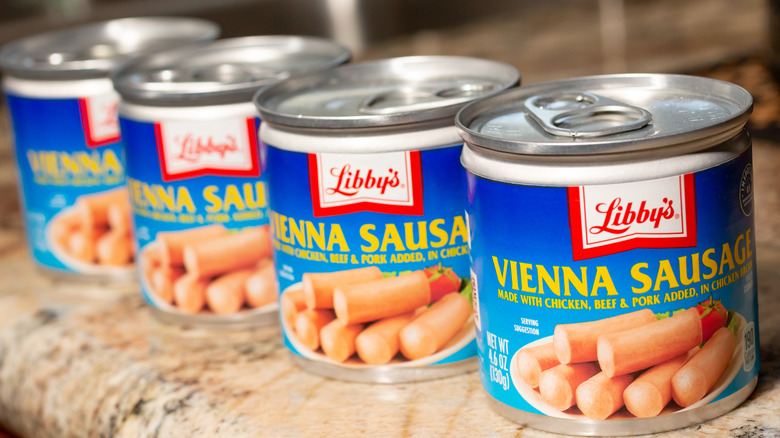No, Vienna Sausages Aren't Just Canned Hot Dogs
Even if you've never tried them, chances are you've seen them on grocery store shelves next to other canned meat classics like Spam and corned beef hash. Of course, we're talking about Vienna sausages. To the unfamiliar eye (and mouth), they may look suspiciously similar to the hot dogs we know and love, just in a can. But the two meaty, savory treats have some subtle but meaningful differences.
The first is obvious to anyone who's taken a bite of each. Vienna sausages tend to be softer in texture than most hot dogs, which offer the familiar light yet snappy casing and firm bite. The second crucial difference doesn't even require tasting them. Vienna sausages are shorter and have open ends, while longer hot dogs are closed within their casings.
There are also some finer distinctions between the two. Traditionally, Vienna sausages included a variety of meat from pigs, cows, and even horses, while frankfurters (the German ancestor of hot dogs) typically used only pork. In modern times, this has changed, with several top hot dog brands like Hebrew National selling all-beef Kosher versions. These are often considered higher-end products than mixed-meat dogs.
The origin is in the name
The two sausages also have crucial differences in their origin. Vienna sausages were originally referred to as wieners, a term derived from the German name for Vienna: "Wien." While it's not clear whether they were first made in Vienna or simply named after the area, they're nonetheless distinct from frankfurters, which unsurprisingly trace their roots to Frankfurt, Germany.
It's important to note that the canned, mass-produced Vienna sausages you'll find on the supermarket shelf differ from the versions available in other parts of the world, particularly Germany and nearby countries. American Vienna sausages are produced from an almost paste-like mixture of meat and spices and fully cooked, sometimes including smoking. European Vienna sausages are typically sold in delis, meat cases, or as street food instead of canned, and are served with a light casing similar to an American hot dog.
So while there are some noteworthy distinctions, the two do share many similarities. That's especially true when compared to the many other types of sausages popular in cultures all across the globe.
Lots of people can't stand Vienna sausages
Another thing you might have noticed that sets hot dogs apart from canned winners is that the former is associated with popular pastimes like baseball and cookouts. One of the enduring mysteries of Vienna sausages, as far as many people are concerned, is why anyone still makes these things. (We're talking about the kind that comes in a can here, not fresh sausages made in the Viennese style.) Are these weenies, perhaps, an acquired taste? If so, it's one that not everyone's been able to acquire.
One Reddit discussion devoted to these sausages did unearth a few fans, although even those who liked them didn't seem to display any overt enthusiasm. The one word that recurred most often in the comments thread, however, was "disgusting," with "gross" running a close second. One Redditor who pulled no punches said of the sausages: "They look like embalmed baby fingers and taste like s***." Over on Quora, these pudgy pink pork(ish) products didn't fare much better. Some said they ate Vienna sausages when they were kids, but couldn't stand them as adults, while one person, who called them "nasty," pointed out that the texture is "nothing like sausage." (Spongy, is what we'd call it.)
There's a chance we've just been eating them wrong, though
Vienna sausages are pre-cooked and can be eaten straight from the can, which makes them convenient for stocking your doomsday bunker. If the zombie apocalypse isn't imminent, however, it might be a better idea to heat them up. As with any ready-to-eat meat product, there's always a slight chance of bacterial contamination that might result in food poisoning (typically listeriosis). Heating them up to a temperature of 165 F should result in a safer sausage. We'd suggest frying, grilling, or baking rather than microwaving the sausages, though, as anything that can alter the texture would be a step in the right direction.
In fact, should you be trying Vienna sausages for the first time, you may wish to take a few extra steps to disguise – er, enhance – the flavor a bit. One Redditor suggests that they could be mixed with ramen and other ingredients to make a kind of DIY budae jjigae, while another recommends using them to make fried rice, then plopping a fried egg on top. Still others prefer dousing them in hot sauce. If you still don't care for these canned sausages even after these or other enhancements, we hear they make excellent fish bait.



